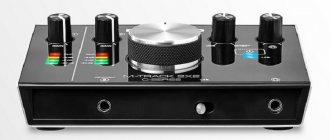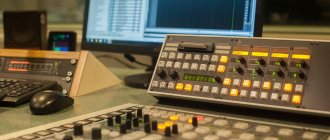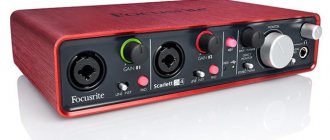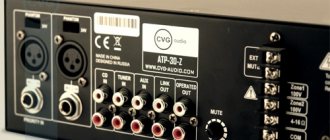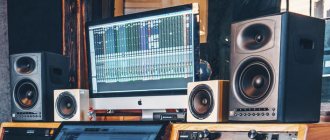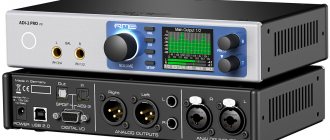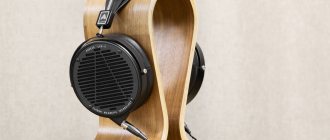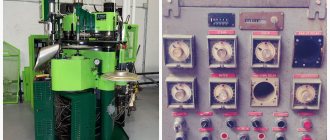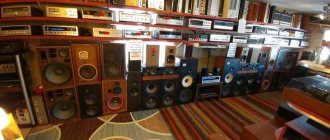Sound card – is a device for analog-to-digital and digital-to-analog audio signal processing (ADC and DAC). Not a single modern recording studio can do without this type of device. The task of any sound card is first of all to digitize an analog signal and then transmit it to the computer. And exactly the same in the opposite direction: convert the digital signal into analog and output it to the amplification unit (or external device). Of course, any computer, as we know, has its own integrated (built-in) sound card. However, for professional, and sometimes even amateur work, it is completely unsuitable. The reason for this is the low quality and weak parameters of the integrated cards. Specialized (specifically music) sound cards, even relatively inexpensive ones, are significantly superior to those previously mentioned in all respects. First of all, integrated cards have a high level of spurious noise. However, ordinary users do not hear them for several reasons: firstly, due to the low quality of sound reinforcement equipment, if any; secondly, the ear of an ordinary listener, due to lack of experience, is so accustomed to these noises that it simply no longer notices them; thirdly, the vast majority of listeners, as a rule, have no idea what high-quality sound actually is. Therefore, if you decide to work with sound, you inevitably and first of all should buy a sound card. Sound cards can be divided into several types:
- PCI cards;
- PCMCIA cards;
- USB cards;
- FireWire cards;
- Thunderbolt cards.
As you understand, the principle is the same for all sound cards. They differ for the most part only in the connection format and execution. Since PCI and PCMCIA cards are gradually becoming a thing of the past and the demand for them is becoming less and less, we will not consider them. Let's talk about the most modern and popular sound cards.
USB sound cards
USB sound cards are the most popular and widespread of all of the above for several reasons. First of all, this is a category of sound cards that are quite affordable in price, but at the same time have good technical parameters and meet all the requirements for working with sound. Plus, they connect to the computer via a traditional USB cable, so there are no connection problems at all. Usually these are 2 or 4 channel cards, although there are 8 channel cards and even more. This means that the card is capable of simultaneously and independently recording 2, 4, 8 external analog channels. It is important to understand that in addition to this, many cards also have digital inputs and outputs, which in turn allow you to additionally record/play a certain number of channels. Digital channels usually have a coaxial and optical connection in the S/PDIF format (Sony/PhilipsDigitalInterface).
Among the large number of USB cards, the following manufacturers can be distinguished: FOCUSRITE, LEXICON, TASCAM.
What does the future hold for audio interfaces?
As we move forward in the name of progress, there will inevitably be new innovations in audio interfaces. More connectivity options. Better compatibility. Clearer transducers and lower latency. Who knows what else?
NAMM is one of the industry's largest trade shows, where developers typically announce their newest and greatest products. Traditionally held every January, gear-hungry musicians and producers salivate over unreleased products. As you might expect, the in-person event hasn't been held for some time, but it's set to happen again this June. Then, I believe, we will get an idea of what the future holds for audio interfaces.
But really, it's about you and your musical journey. So….
FireWire sound cards
FireWire sound cards are a segment of the more expensive cards for several reasons. First of all, the difference between this type of card lies in the FireWire connection itself. This is a newer data transfer format that differs from its predecessor USB in the data transfer speed. This is especially important during multi-channel recording or playback. Therefore, this type of connection is usually used on 4 or more channel cards (with rare exceptions). Cards of this type use higher quality ADC and DPA converters, which also affects the sound quality and explains the higher cost of the product. However, to connect them, if the computer does not have a FireWire port, you have to buy an appropriate expansion card, which we will talk about later, and of course the appropriate cable for sound cards of this type. FireWire cards from such manufacturers as RME, APOGEE, AVID are in particular demand among sound engineers.
What to consider
Again, it depends on what kind of music you make and how you make it.
Connection
First of all, you need to decide how you will connect to your computer. If you have a free USB port, you can choose from many models. USB interfaces are the most common way to connect an audio interface to a computer, especially as technology improves data transfer speeds. If you have Thunderbolt ports, that opens up additional options, and if you're still hanging on to Firewire, there are options there, too.
Inputs
The next thing to think about is how many inputs you will need. If you're a one-woman home studio recording tracks one at a time, one input is sufficient. For multi-track recording you will need more inputs.
If you're recording from an instrument, like that dusty Korg M1 in the corner, you'll need at least one instrument input. Playing rock through a Marshall stack and recording it with well-placed mics? You will need a microphone input and phantom power if it is a condenser microphone. If you are using USB microphones for recording, please note that they will not be included in the signal path of the interface.
Exits
Likewise, consider where the audio interface's output will be routed. If you're connecting a pair of studio monitors, you'll need to make sure the interface's outputs are compatible with your monitors' inputs.
Will you be using external preamps or effects processing? To do this you will need additional outputs.
Headphone outputs
For monitoring you will need headphone outputs. Their number depends on the number of people who will sign up at the same time. Most audio interfaces come with at least one output.
MIDI
Do you need midi connectivity? MIDI keyboards today can be plugged directly into one of your computer's other USB ports, but if you have an older keyboard, you'll need an audio interface that allows you to connect using good old MIDI cables.
Software packages
Almost every audio interface comes with one set of software or another. While this shouldn't be the deciding factor in choosing a model, it's worth considering whether the free programs that come with the interface will actually be useful to you. For example, if you already own the Native Instruments Komplete collection, the software that comes with the interfaces won't be of much use to you, but the software offered by Universal Audio might be.
Future growth
It's worth adding here that it's worth thinking about how your studio's needs might change in the future. If you're looking into your crystal ball and seeing growth, there's more to consider when choosing an audio interface.
With all these considerations in mind, what are the best audio interfaces on the market?
Thunderbolt sound cards
Thunderbolt sound cards - like cards of the previous type, differ mainly in the connection format. Thunderbolt is the most modern data transfer format with record parameters: 10 Gbit/s when transferring data over a copper cable and up to 20 Gbit/s when transferring data over an optical cable. Therefore, this type of connection is usually used in professional multi-channel sound cards. Almost all cards of this type have a standard 19-inch rack design with a size of 1-2 units. Also, many of them have a so-called modular layout. This means that the card itself is produced with free slots for independent installation of the necessary modules. For example, it may consist of a main block, and each buyer individually selects the input and output modules for himself, taking into account his own tasks. As an example, we can consider a sound card model such as: APOGEE Symphony I/O MKII Thunderbolt Chassis.
RME Fireface UC Audio/MIDI Interface
Another device is a USB interface, in 1U format, which has a USB bus and through this bus automatically adapts to the technical capabilities of your computer, thereby providing superior processing speed with minimal computer load than devices on the Firewire bus.
The unit has eight balanced analog outputs and a further eight channels simultaneously accessible via ADAT and S/PDIFF (which can also be accessed via ADAT), two Neutrik Combo XLR mic connectors and a TRS with up to 65dB preamp. If one device is not enough, you can connect up to three devices to one computer for more inputs/outputs. There are also MIDI I/Os available on the rear panel via a common MIDI connector. The device can be used as an independent encoder to set levels and parameters. This device has the most excellent sound quality of any device in our review.
| RME Fireface UC Audio/MIDI Interface | |
| Converters | 24-bit |
| Supported Sample Rate (khz) | up to 192kHz |
| Total SimultaneousOutputs | 18 |
| Total Simultaneous Inputs | 18 |
| Total Analogue Outputs | 8 |
| Total Analogue Inputs | 8 |
| Microphone Inputs | 2 analogue inputs on XLR/TRS Combi |
| ADAT | 8 |
| S/PDIF | 2 |
| MIDI | Yes |
| Mic Preamps | Yes |
| USB/Firewire | USB 2.0 |
| Bus Powered | No |
| System Requirements | Mac: Mac OS X (10.5 or higher) Intel: Core Audio, Core MIDI |
| PC: Windows XP (from SP2), Vista, Vista 64, 7: Full ASIO multi-operation of WDM and ASIO 2.0 WDM (Directsound) with stereo and multi-Channel support. |
Expansion cards
Expansion cards - or expansion modules - are additional units designed for self-installation into a computer or professional audio equipment of your choice. For example, expansion cards are often used for a computer, which allow the transfer of data in FireWire or Thunderbolt formats, which we talked about earlier. For professional equipment, they are also used to expand the functionality of a particular equipment.
Do I need an audio interface?
It depends on what kind of music you produce and how you want to listen to it. If you're a headphone mixer, all you need to do is use a USB-Midi input controller and headphone jack on your laptop or PC.
If you want to record instruments or voices, you'll need a way to feed an analog signal into your computer. Additionally, you will need a way to monitor the recording.
And if you want to impress your roommates with your creation, you'll need a way to connect speakers to it so the whole world knows it's time to fire up.
For a more in-depth look at what an audio interface actually does, check out this article. I'll be waiting here when you're done.
Ready? So, what should you look for when choosing an audio interface?
Buy a sound card
To buy a sound card, you can place an order through the shopping cart on our website, or simply call our specialists, who, in turn, will give you professional advice and help you make the right choice.
]Audio-Video[/anchor] is an official dealer and leading specialist in the field of sales of professional audio and video equipment from the world's leading manufacturers. When purchasing any product on our website, you will receive the best price offers, as well as an official guarantee from the manufacturer. All products are official and certified.
Focusrite Saffire PRO 40 Audio Interface
This device is closer to the more professional range, but the downside is that it is quite expensive for home use. It has the ability to be powered via Firewire, 20 inputs/outputs, 1U format, eight Focusrite preamps, phantom power on each channel (1 and 2 have -9dB). Neutrik Combo jacks with 10 TRS analog outputs, ADAT I/O and S/PDIFF available. The device works in standalone mode without a computer, and has Saffire MixControl DSP - a unique mixer that allows you to control all possible parameters and channels. There is a headphone output option (-42 up to 0dB).
| Focusrite Saffire PRO 40 Audio Interface | |
| Converters | 24-bit |
| Supported Sample Rate (khz) | up to 96kHz |
| Total Simultaneous Outputs | x20 |
| Total Simultaneous Inputs | x20 |
| Total Analogue Outputs | x12 |
| Total Analogue Inputs | x12 |
| Microphone Inputs | 8 analogue inputs on XLR/TRS Combi |
| S/PDIF | x2 |
| ADAT | x16 |
| Mic Preamps | Yes |
| MIDI | Yes |
| USB/Firewire | Firewire |
| Bus Powered | No |
| System Requirements | Mac: OSX (10.4 and 10.5), PowerPC G4/Dual 1 GHZ or faster or any Intel-based model. RAM 512 MB (more recommended) |
| PC: Microsoft Windows XP SP2 (32-bit and 64-bit), Microsoft Windows Vista (32-bit and 64-bit), 900MHz AMD or Pentium. (1.5 GHz or higher recommended), RAM 512 MB (more recommended) |
Computer connection
USB : the most popular connector. Please note that connector and bus are two different things! It happens that the device connector is already Type-C, and the bus operates according to the old 2.0 standard. iOS-compatible devices also connect via USB.
FireWire : Mac format that is slowly being replaced by Thunderbolt. The connector is fast and suitable for multi-channel recording.
Thunderbolt : New Apple computers are equipped with this bus. Owners also manage to install an expansion card. The format is characterized by a very high data packet transmission rate and ultra-low latency.
PCIe (PCI Express) : internal card format for desktop computers. Occupied a niche of professional solutions for large studios and users of the Avid ProTools ecosystem. PCIe offers high bandwidth and low latency. Cards usually have a large number of connectors.
Focusrite Saffire PRO 14: 8 In/6 Out Firewire Audio/MIDI Interface
Small compact solution with 14 inputs and 6 outputs, including Firewire. The circuitry of this device and hardware processing are similar to its older brother PRO 40. It has universal Neutrik Combo XLR inputs/outputs, 48 V phantom power for microphones on the front panel.
| Focusrite Saffire PRO 14: 8 In/6 Out Firewire Audio/MIDI Interface | |
| Converters | 24-bit |
| Supported Sample Rate (khz) | up to 96kHz |
| Total Simultaneous Outputs | 6 |
| Total Simultaneous Inputs | 8 |
| Total Analogue Outputs | 4 |
| Total Analogue Inputs | 6 |
| Microphone Inputs | 2 analogue inputs on XLR/TRS Combi |
| Mic Preamps | Yes |
| S/PDIF | 2 |
| MIDI | Yes |
| USB/Firewire | Firewire |
| Bus Powered | Yes |
| System Requirements | Mac: • Computer: Apple Macintosh with FireWire 400 support • CPU/Clock: PowerPC G5 2GHz (Leopard) or Intel 2GHz (Snow Leopard) • Memory (RAM): 1GB (2GB or more recommended) • Screen Resolution: 1024×768 ( 1280×1024 or more recommended) |
| PC :• Computer: Windows compatible computer with FireWire 400 support • CPU/Clock: Pentium or AMD with 1.6GHz or higher (Dual 1GHz or higher recommended) • Memory (RAM): 1GB (2GB or more recommended) • Screen Resolution: 1024 ×768 (1280×1024 or more recommended) |
Tascam US 122MKII (USB 2.0audio/MIDI interface)
Tascam is known as one of the best companies that make entry-level professional products. This device is intended for those who value compactness and periodically carry such a device with them for work.
| Tascam US-122 MKII USB Audio Interface | |
| Converters | 24-bit |
| Supported Sample Rate (khz) | up to 96kHz |
| Total Simultaneous Outputs | 2 |
| Total Simultaneous Inputs | 2 |
| Total Analogue Outputs | 2 |
| Total Analogue Inputs | 4 |
| Microphone Inputs | 2 analog inputs on XLR |
| Mic Preamps | Yes |
| MIDI | Yes |
| USB/Firewire | USB |
| Bus Powered | Yes |
| System Requirements | Mac: OS X 10.4 or higher, 1GB, 500MB Hard disk space, free USB port |
| PC: Windows XP, Vista, Windows 7, 1GB, 500MB Hard disk space, free USB port | |
ESI U24 XL
This is the most budget option for those who have an old laptop and a great desire to create music. Comes with Cubase LE, has a 24-bit processor, 2 analog inputs and 2 analog outputs with 1/4 TRS jacks. It is possible to connect a digital signal via an optical Toslink and a coaxial RCA connector. The compact and modern body is made of durable aluminum. Choosing the economical ones.
| ESI U24 XL | |
| Converters | 24-bit |
| Supported Sample Rate (khz) | 48kHz |
| Total Simultaneous Outputs | 2 |
| Total Simultaneous Inputs | 2 |
| Total Analogue Outputs | 2 |
| Total Analogue Inputs | 2 |
| USB/Firewire | USB |
| Bus Powered | Yes |
| System Requirements | Mac: Mac OS X 10.4 and higher |
| PC: Windows 7/Vista/XP |
Alesis iO2 Express 24-Bit USB Audio/MIDI Interface
Excellent, small model, has 2 inputs/outputs for home use. Alesis has always tried to balance the price/quality ratio optimally, this model is no exception, offering a well-designed interface that boasts XLR, TS jacks for line input, which allows it to be used with DJ equipment, microphones and guitars with the ability to control simultaneously with USB entrance. The build quality is very high.
| Alesis iO2 Express 24-Bit USB Audio/MIDI Interface | |
| Converters | 24-bit |
| Supported Sample Rate (khz) | up to 48kHz |
| Total Simultaneous Outputs | 2 |
| Total Simultaneous Inputs | 2 |
| Total Analogue Outputs | 4 |
| Total Analogue Inputs | 2 |
| Microphone Inputs | 2 analog inputs on XLR |
| Mic Preamps | Yes |
| S/PDIF | 2 |
| MIDI | Yes |
| USB/Firewire | USB |
| Bus Powered | Yes |
| System Requirements | Mac: Any Apple computer with native USB support OS X 10.2 or later 128MB RAM |
| PC: Pentium III 450MHz processor Windows XP (with Service Pack 2 installed) 128MB RAM Available USB 1.1 Port | |
Mackie Onyx Artist
The price is about 10,000 rubles.
The case of the Mackie Onyx Artist USB audio interface is made of aluminum, which has a very positive effect on its resistance to external interference and mechanical damage.
Supports 24 bit/192 kHz mode. On the front panel there are XLR and TRS connectors, keys for activating zero-latency monitoring and turning on +48V phantom power.
There is a headphone output with separate volume control, a convenient indication of overload and the presence of a signal at the input, and the handles are equipped with additional rubber pads - they are very convenient to use. On the rear side there is a pair of TRS output connectors.
The sound card is connected to the computer via USB; no external power supply is required. The audio interface is equipped with DAW Tracktion T7 and a set of plug-ins for audio signal processing.
ASUS Xonar U5
Price is about 5500 rubles.
Almost the same as Creative X-Fi, only without a remote control. The stream actually increased to 24 bit / 192 kHz. ASIO 2.0.
But mini-jacks have now become total. So why do this?
ASUS Xonar U5 has a C-Media CM6631A processor. CM9882 DAC connected to the DSP via the HDA interface. It provides line and microphone inputs, headphone output, as well as three analog audio outputs for 5.1 speaker systems. The CM9882 provides a signal-to-noise ratio of 106dB and harmonic distortion + noise of -95dB(A). On the weekend
The headphones use a separate operational amplifier, the recommended resistance is up to 150 ohms.
